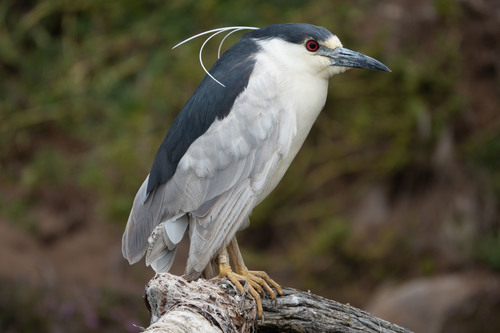
Black-crowned Night-heron
The Black-crowned Night-Heron (*Nycticorax nycticorax*) is a medium-sized heron found throughout a large part of the world. Unlike many herons that are active during the day, this species is primarily nocturnal, feeding at dusk and dawn. This behavior reduces competition with other heron species in the same habitat. They play an important ecological role as both predator and prey, controlling populations of small animals while also serving as food for larger predators. The Black-crowned Night Heron holds little specific cultural significance in many regions, though its widespread presence has made it a familiar sight in wetlands across the globe.
58-66 cm
Length
115-118 cm
Wingspan
Least Concern
Conservation Status
Distribution
Found on every continent except Antarctica and Australia. Breeds in North and South America, Europe, Asia, and Africa. Northern populations migrate south for the winter, while tropical populations are generally resident. They have an extensive altitudinal range, from sea level to 4,000 meters.
Lifespan
Up to 21 years in the wild (oldest recorded individual), typically shorter.
Black-crowned Night-heron's Habitat
Habitat Types
Freshwater wetlands, Saltwater marshes, Mangrove swamps, Lakes, Rivers, Rice paddies, Estuaries
Climate Zones
Tropical, Subtropical, Temperate
Adaptations
Their nocturnal habits are a key adaptation. They possess excellent night vision, allowing them to forage effectively in low-light conditions. Their relatively short legs and stocky build are suited for wading in shallow water and navigating dense vegetation.
Variations
Four subspecies are generally recognized: *N. n. nycticorax* (Eurasia), *N. n. hoactli* (North and Central America), *N. n. obscurus* (South America), and *N. n. falklandicus* (Falkland Islands). These subspecies differ slightly in size and plumage coloration.
Appearance
Breeding Plumage
Adults in breeding plumage have a black crown and back, contrasting with gray wings and underparts. Non-breeding adults are slightly duller. Juveniles are brown with extensive streaking and spotting.
Seasonal Feather Changes
Adults develop two or three long, white plumes on the nape during the breeding season.
Sex Based Plumage Differences
Minimal; males and females have similar plumage.
Notable Features
Black crown and back (in adults), Thick neck and relatively short legs, Red eyes, Long, white head plumes during breeding season
Diet and Feeding
Primary Foods
Fish, Amphibians, Crustaceans, Insects, Small mammals, Reptiles, Occasionally eggs and young birds
Foraging Behavior
Primarily hunts at night or in the twilight hours. Often stands motionless at the water's edge, waiting for prey to approach. May also wade slowly or walk on floating vegetation.
Specializations
Excellent night vision aids in nocturnal hunting. They have a rapid strike capability to capture prey.
Seasonal Diet Variations
Diet varies depending on prey availability. During the breeding season, they may focus on larger fish to feed their young. In winter, they may consume more crustaceans and insects if fish are scarce.
Behavior
Social Structure
Often nests colonially, sometimes in mixed-species colonies with other herons and egrets. Outside of the breeding season, they may roost communally in large groups.
Communication
Loud 'quok' or 'wark' calls, especially at night, Bill snapping during courtship, Variety of croaks and squawks within the colony
Migration
Northern populations are migratory, moving south to warmer climates for the winter. Southern populations are often resident or only make short-distance movements.
Territorial or Group Behaviors
Defends nesting territories within the colony. Foraging is often solitary, but they may tolerate other individuals nearby.
Conservation
Threats
Habitat loss and degradation (wetland drainage), Pollution (pesticides and heavy metals), Human disturbance at nesting colonies, Climate change (altered rainfall patterns), Hunting (in some regions)
Protection Programs
Wetland conservation and restoration efforts, Monitoring of pesticide levels in prey, Protection of nesting colonies from disturbance, International Migratory Bird Treaty Act (in North America)
Local National Laws
Protected under various national and international laws, including the Migratory Bird Treaty Act in the United States and Canada, and the Birds Directive in the European Union.
Population Trend
Stable
Population Estimates
Global population estimated to be between 1,700,000 and 4,100,000 individuals.
Interesting Facts
They are one of the most widespread heron species in the world.
Their adaptability to various wetland habitats has allowed them to thrive on multiple continents.
Juveniles look very different from adults.
Their brown, streaky plumage provides camouflage in their early stages of life.
They sometimes use bait to attract fish.
While rare, they have been observed dropping small objects into the water to lure fish closer.
Black-crowned Night Herons are bioindicators.
Their health and population size can indicate the quality of the wetland environment.
Faqs about Black-crowned Night-heron
What is the difference between a Black-crowned Night-Heron and a Yellow-crowned Night-Heron?
While both are night-herons, the Yellow-crowned Night-Heron has a yellow crown and a different facial pattern. Yellow-crowned Night Herons also have a more restricted range, primarily in the Americas, and prefer crustaceans.
Where can I see a Black-crowned Night-Heron?
Look for them in wetland areas at dawn and dusk. They are often found near the edges of lakes, ponds, marshes, and estuaries.
Are Black-crowned Night-Herons endangered?
No, they are classified as 'Least Concern' by the IUCN. However, local populations may be threatened by habitat loss and pollution.
Do Black-crowned Night-Herons make any sounds?
Yes. The most common call of the Black-crowned Night-Heron is a flat, croaking *quok* or *quark*, often heard at dusk or during the night.
Copyright @ Nature Style Limited. All Rights Reserved.
 English
English